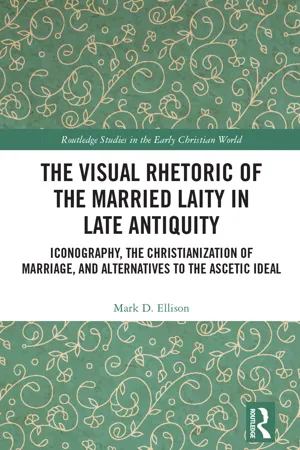
The Visual Rhetoric of the Married Laity in Late Antiquity
Iconography, the Christianization of Marriage, and Alternatives to the Ascetic Ideal
- 400 pages
- English
- ePUB (mobile friendly)
- Available on iOS & Android
The Visual Rhetoric of the Married Laity in Late Antiquity
Iconography, the Christianization of Marriage, and Alternatives to the Ascetic Ideal
About this book
This study examines third- and fourth-century portraits of married Christians and associated images, reading them as visual rhetoric in early Christian conversations about marriage and celibacy, and recovering lay perspectives underrepresented or missing in literary sources.
Historians of early Christianity have grown increasingly aware that written sources display an enthusiasm for asceticism and sexual renunciation that was far from representative of the lives of most early Christians. Often called a "silent majority," the married laity in fact left behind a significant body of work in the material record. Particularly in and around Rome, they commissioned and used such objects as sarcophagi, paintings, glass vessels, finger rings, luxury silver, other jewellery items, gems, and seals that bore their portraits and other iconographic forms of self-representation. This study is the first to undertake a sustained exploration of these material sources in the context of early Christian discourses and practices related to marriage, sexuality, and celibacy. Reading this visual evidence increases understanding of the population who created it, the religious commitments they asserted, and the comparatively moderate forms of piety they set forth as meritorious alternatives to the ascetic ideal. In their visual rhetoric, these artifacts and images comprise additional voices in Late Antique conversations about idealized ways of Christian life, and ultimately provide a fuller picture of the early Christian world. Plentifully illustrated with photographs and drawings, this volume provides readers access to primary material evidence. Such evidence, like textual sources, require critical interpretation; this study sets forth a careful methodology for iconographic analysis and applies it to identify the potential intentions of patrons and artists and the perceptions of viewers. It compares iconography to literary sources and ritual practices as part of the interpretive process, clarifying the ways images had a rhetorical edge and contributed to larger conversations.
Accessibly written, The Visual Rhetoric of the Married Laity in Late Antiquity is of interest to students and scholars working on Late Antiquity, early Christian and late Roman social history, marriage and celibacy in early Christianity, and early Christian, Roman, and Byzantine art.
Frequently asked questions
- Essential is ideal for learners and professionals who enjoy exploring a wide range of subjects. Access the Essential Library with 800,000+ trusted titles and best-sellers across business, personal growth, and the humanities. Includes unlimited reading time and Standard Read Aloud voice.
- Complete: Perfect for advanced learners and researchers needing full, unrestricted access. Unlock 1.4M+ books across hundreds of subjects, including academic and specialized titles. The Complete Plan also includes advanced features like Premium Read Aloud and Research Assistant.
Please note we cannot support devices running on iOS 13 and Android 7 or earlier. Learn more about using the app.
Information
Table of contents
- Cover
- Endorsements
- Half Title
- Series
- Title
- Copyright
- Contents
- List of Figures
- List of Tables
- Acknowledgements
- Prologue: The Monk and the Matrona
- 1 Introduction: Recovering the Voices of “the Silent Majority”
- 2 Competing Visions: Early Christian Thought on Marriage and Celibacy
- 3 Centering Christ: Adaptations of Dextrarum iunctio, Concordia Pronuba, and Coronae impositio in Spousal Portraits
- 4 Learned, Encircled, Worshipping: Other Forms of Double-Portraits and Self-Representation
- 5 In the Beginning: Married Christians Putting Adam and Eve to Work
- 6 After the End: Marriage, Death, and the Afterlife
- 7 Conclusion: Image and Word in the Conversations of the Christian Past
- Appendix: Adam and Eve Images and Marital Contexts on Christian Sarcophagi
- List of Abbreviations
- References: Ancient Sources
- Bibliography
- Index